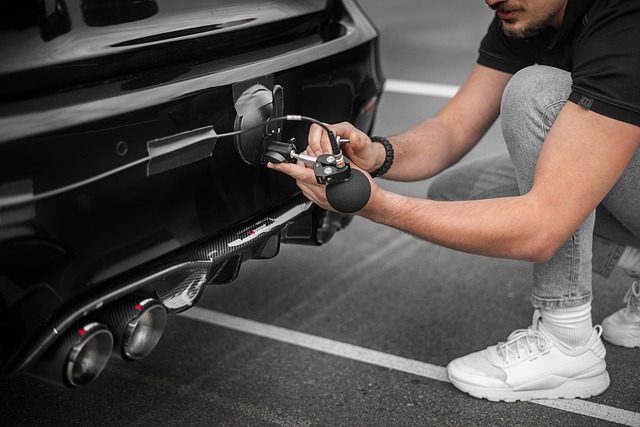Registering a car in California is a straightforward process, but understanding the requirements and gathering the right documents is essential. This guide will walk you through the steps, from gathering necessary information like your vehicle’s VIN (using a trusted DMV VIN verifier) to completing the registration at a local DMV office or online. By following these simple steps, you’ll have your California car registration in no time.
- Understand the Requirements for Car Registration in California
- Gather Necessary Documents and Vehicle Information
- Visit a California DMV Office or Use the Online System
- Complete the Registration Process: Step-by-Step Guide
- Verify Your Vehicle's Identification Number (VIN) with a Trusted Service
Understand the Requirements for Car Registration in California

Before registering your car in California, it’s crucial to understand the requirements set by the Department of Motor Vehicles (DMV). One key step is ensuring a valid Vehicle Identification Number (VIN) inspection or verification. The DMV recommends using an official VIN verifier to check the vehicle’s history and ensure its authenticity. This process involves scanning the unique VIN code, which can be found on the vehicle’s registration certificate and often etched into the car’s chassis.
A mobile VIN inspection or verification is another convenient option, where specialized services come to you. These services utilize advanced technology to cross-reference the VIN with national databases, providing instant access to detailed vehicle history reports. This includes information about prior ownership, accident records, and any outstanding issues related to the car’s title or registration, ensuring a smooth registration process in California.
Gather Necessary Documents and Vehicle Information

Before registering your car in California, it’s crucial to gather all necessary documents and vehicle information. This includes your driver’s license, proof of insurance, and vehicle registration from any previous state (if applicable). Additionally, you’ll need the Vehicle Identification Number (VIN) from your car, which can be found on the vehicle’s title or in its manual. For a hassle-free process, consider using a mobile VIN verifier to quickly and accurately obtain this crucial detail.
Ensure that all information is up to date and accurate. In some cases, you might need a bill of sale or a completed California Vehicle Purchase Agreement. Also, have your vehicle inspected by a certified technician to verify its condition and ensure it meets state safety standards. This step, combined with using reliable tools like mobile VIN verification services, will help streamline the registration process at the California Department of Motor Vehicles (DMV).
Visit a California DMV Office or Use the Online System

In California, registering a car involves either visiting a DMV office or utilizing their online system, both of which are convenient and accessible options for vehicle owners. If you prefer face-to-face interaction, making an appointment at your nearest California Department of Motor Vehicles (DMV) office is advisable. This ensures a smoother process as you’ll be able to complete the registration and obtain your vehicle’s license plate on the same day. The DMV staff will guide you through the necessary steps, which include providing essential documents like proof of insurance, ownership records, and identification.
For those who prefer a digital approach, California’s DMV offers an online registration system that streamlines the process. Before initiating the online procedure, ensure you have your vehicle’s unique Vehicle Identification Number (VIN) at hand, as it’s crucial for verifying ownership during the registration. A mobile VIN verifier or even a traditional vin inspection can help confirm your car’s authenticity and make the registration process faster and more efficient.
Complete the Registration Process: Step-by-Step Guide

After gathering all the necessary documents, it’s time to complete the registration process at your local California DMV (Department of Motor Vehicles). Here’s a step-by-step guide:
1. Submit Your Documents: Arrive at the DMV with your vehicle’s registration paperwork, proof of ownership (like a title or bill of sale), and identification documents such as your driver’s license or state ID card. If you’re transferring ownership, bring along the seller’s signature and their identification as well.
2. VIN Verification: A crucial part of the process involves using a DMV VIN verifier to ensure the vehicle’s identity. This is typically done by entering the Vehicle Identification Number (VIN) into a secure system to check for any issues or discrepancies. You can use a traditional vin inspection at the DMV office or opt for a convenient mobile vin verification service, allowing you to complete this step quickly and efficiently from your smartphone.
Verify Your Vehicle's Identification Number (VIN) with a Trusted Service

Before registering your car in California, it’s crucial to ensure your vehicle’s Identification Number (VIN) is accurate and valid. One reliable way to verify this critical piece of information is through a trusted VIN verifier service. These services offer both online and mobile vin verification options, making them convenient for Californians looking to register their vehicles. Using a mobile vin verifier app allows you to quickly scan your car’s VIN and receive instant validation, ensuring there are no discrepancies that could delay the registration process.
To streamline the registration process, choose a service that offers comprehensive vehicle history reports, as well. This extra step can help catch any potential issues or red flags associated with your car’s past, giving you peace of mind before committing to the registration. Whether using an online platform or mobile vin inspection tool, this simple verification step is a vital part of ensuring your vehicle meets California’s requirements.
Registering your car in California is a straightforward process, whether you choose to do it in-person at a DMV office or online. By understanding the requirements, gathering all necessary documents and vehicle information, and completing the registration steps accurately, you’ll have your car registered and ready to hit the road in no time. Don’t forget to verify your Vehicle Identification Number (VIN) using a trusted service like a dmv VIN verifier for added peace of mind.



